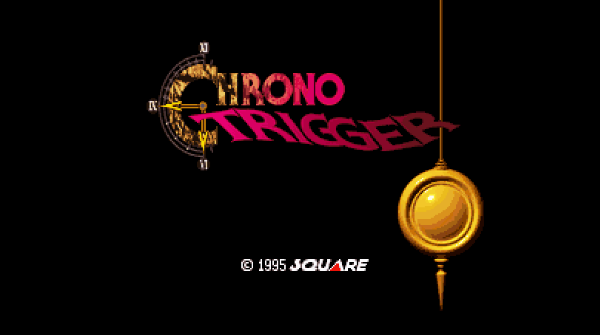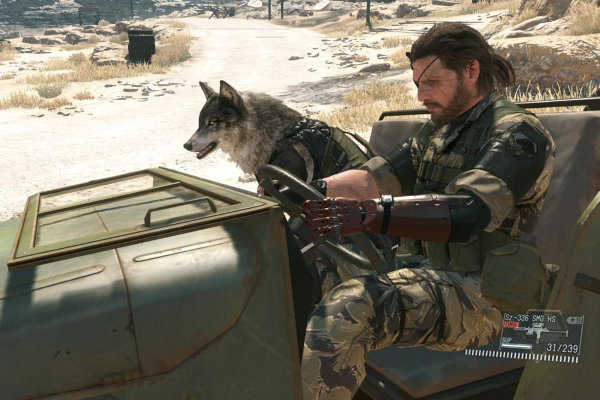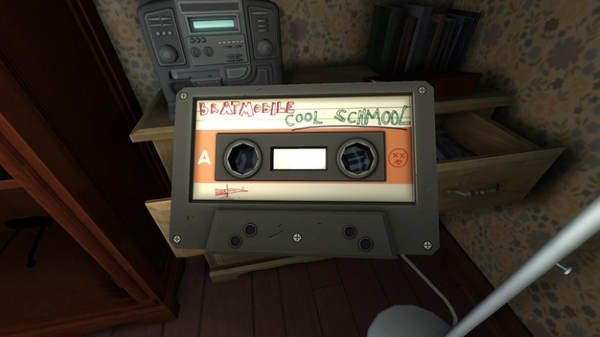
After sinking what seemed like at least fifty hours into Metal Gear Solid V: The Phantom Pain (I could have checked the in-game clock, but I didn’t feel like deep-menu-diving), I frantically but successfully dispatched the requisite Giant Fucking Robot (GFR) that stood between me and the endgame.
That’s how you know you’re at the end of a Metal Gear Solid game: You find yourself face to face with a GFR, and you blow it up with missiles. It’s like clockwork. You could set your watch to it. You shouldn’t do that, of course—a GFR’s arrival is no useful kind of time measurement—but you could.
Something’s different in MGS V, though, and it’s deeply unsettling. Hideo Kojima, whether in revenge for his ignoble ousting from Konami or simply because his ego has grown bigger than Big Boss, made the balls-of-steel executive decision to cap every single mission in the game with credits identifying him as the game’s director.
Naturally, such a decision leads to a series of existentially twisty, Philosophy-101-Lite questions: Is a game that effectively “ends” after each mission ever really “over”? How do you know when to call it quitsies and move on to something else? Do videogames really end at all anymore?
Like any half-decent philosophical questions worth their salt (their salt is expensive), these aren’t easily answered, but they might make for some good discussion fodder. I’ll keep using MGS V as a primary example, if only because it’s what I’ve been working on lately (and because, by now, it’s basically turned into a part-time job).

Back in the Day
It used to be the case that, when you dispatched the final boss of a game, that was it. Curtains. The game’s over, congratulations, you win, you’re done. Go play outside and get some sun, you agoraphobic phantom. If you were lucky, the game designer programmed in a perfunctory closing story sequence to tie up loose ends and make you feel like it was all worth your while, like you accomplished something, but more often, the ending was just that: the end. Two options: Jab the reset button and start over, or shut the whole thing down and do something else.
Towards the end of the Super Nintendo’s life-cycle, however, Chrono Trigger tried out a scary new way to finish games: Don’t finish them at all. The bones of Chrono Trigger’s “New Game+” system are buried in predecessor games—to cite one famous example, The Legend of Zelda allowed for a second playthrough in a scrambled-up, more difficult version of the original game world—but it was Chrono Trigger that, for better or worse, inspired hordes of future developers to incentivize repeat go-arounds of their games by subtly (or not-so-subtly) altering the playing experience.
In Chrono Trigger, taking down Lavos, an oversized space-pincushion controlled from the inside by the late David Bowie, rewarded the victorious player with the option to restart the story while retaining all items and stats accrued the first time through, the better to view the game’s various endings. Each ending required certain conditions to be met during a playthrough, and New Game+ opened up the possibility of meeting those conditions and viewing alternate endings without investing the countless hours that would be required when starting from scratch.
New Game+ was such a revolutionary system that it eventually became a mainstay of not only the JRPG genre, but games generally, to the point that greedy, entitled gamers began to expect it as a tasty dessert to their gaming entrees and to revolt when it wasn’t offered. That’s a win-win, right? It seems nigh indisputable that so long as the main game offers a fully fleshed-out experience, New Game+ represents pure bonus value, more bang for the buck.
But does there come a point when the buck has bought too much bang?

Time Extended!
I’ll answer that one outright: Yep. Metal Gear Solid V is a great example of the disturbing direction in which the New Game+ system has evolved. I’m pretty sure it’s not the only example of the trend, but I have no way of knowing for sure because, well, I can’t seem to finish Metal Gear Solid V. I thought I’d finished it when I obliterated that GFR I mentioned earlier—for shit’s sake, there was a fade-to-black and ten minutes of full-screen credits—but I burst into incredulous, panicked laughter when the credits ended and “Chapter 2” flashed ominously across the screen. Chapter 2? Out of… out of how many? Were they all that long? What about my job? My family?
Without diving too deeply into spoiler territory, it turns out that Chapter 2 is mostly optional. Still, it contains enough substantive plot that, if you don’t play through it, you won’t get nearly the whole story. Come to think of it, though, the story feels thoroughly incomplete even after wrapping up Chapter 2, and I’m pretty sure there are no plotty missions left for me to complete at this point. That might speak more to the tumultuous nature of the MGS V development process than it does to gaming as a whole, but that doesn’t make me feel any less anxious about the “53% Complete” badge of shame hovering below Big Boss as he broods in his copter with the main menu plastered across his face.
So, a quick summary: I finished the story, I completed a substantial number of side ops (seriously, I did!), I developed all kinds of fancy new weapons and explosive knickknacks, I built out Mother Base to its full capacity, and, somehow, I completed no more than roughly half of the game. What in the holy hell could that leftover 47% possibly consist of, and is it really worth my time to find out? In powering through today’s infinitely extended games, that’s the real question, the one that tickles the back of my brain: not “when is this game over?” but “when is this game over for me?”
As it turns out, MGS V was over for me at 53%. Numerically, I’ll be leaving half of the game unplayed, but I’m learning that the completionist instinct within me has no place in this strange new world. I got what I wanted out of the game—a glancing attempt at a wacky story, some truly epic sniping battles, balloons to attach to tanks, heat-seeking rocket launchers—and now I’m finished. It may be that I’ll revisit the game later on and blow through a few side ops, but I’m not going to prioritize it. I have other games to play.

Who Cares?
Why does any of this matter? Who cares if games don’t really end anymore, but instead continue to plod along, existing in perpetuity? Well, I do, for one—I don’t know when to put the game down otherwise, or I’m at least forced to make uncomfortable decisions about when to slowly back away from it.
I’m noticing an emerging dichotomy between gameplay and story that’s becoming more pronounced as technology makes the sort of expansive game universe featured in MGS V more and more accessible, and which side of the dichotomy a game falls on has a direct impact on how—and even whether—that game ends.
In a lot of ways, MGS V is a weird example to use, given that it’s at least as well known for its (ahem) “lengthy” cinematics as it is for its often stellar gameplay (it hasn’t always been clear if MGS is a movie masquerading as a game or vice versa), but the point actually applies quite directly: The bigger the world and the fewer restrictions placed on the player in exploring that world, the looser the story and less “final” the ending.
Past MGS games have been celebrated for their tight narratives, but those games were also considerably more linear than MGS V, which rather profoundly sacrifices any attempt at a coherent, satisfying story to make way for a massive desert-and-jungle-themed sandbox. Now, I like playing in a sandbox just as much as the next two-year old, but when the narrative wraps up and all I’m left with is the sand, it starts to feel a little like my mom forgot to come pick me up and left me abandoned at the playground. Sure, I could tinker around in the desert endlessly, but if I did, it would be solely for whatever implicit joy can be found in tinkering—there would be no concern for what might happen next, because it would be understood that nothing is happening next.
There’s a flip side to this, of course. There are plenty of games that do still end when the story is over, and they’re—certainly not coincidentally—almost all heavily narrative-driven or, at the very least, confined to a relatively linear world.
Logically, that makes sense: The more limited the game world, the easier it is for a developer to script a complex story by restricting the possible variables. When a player can do whatever he wants whenever he wants, there’s no feasible way to predict every possible permutation of the what and when—to script events accordingly—so the story has to necessarily relax its grip on the game to allow for that freedom. Likewise, when the story runs out, the game’s over.
For instance, I recently found myself watching the credits roll at the end of Broken Age, a deliberately old-school point-and-click adventure game, and although I dutifully thumb-twiddled through to the end to await whatever endgame bonus might be gifted my way, I was eventually kicked back to the main menu. Nothing. Broken Age had no time for my need to explore huge, fully realized open worlds, no patience for my instinct to aimlessly wander the desert, sniping enemy soldiers from faraway hilltops for no real reason other than to quench my own bloodlust. Broken Age wanted me to solve item-based puzzles, and it wanted to tell me a carefully written, affecting story in return. Seems like a fair tradeoff.

Game Over
In a sort of backlash to the open-ended sandbox-style popular in so many AAA titles today, other games have pushed even further in the direction of strict narrative and finality over gameplay. Games like Gone Home, Everybody’s Gone to the Rapture, and Firewatch don’t give the player much to actually do except stroll along a set corridor and take it all in. There’s no need to remember to stop and smell the roses—there’s nothing but roses. The story is the only point of the game, and without it there would be nothing but an empty dollhouse, a meticulous setting saturated with atmosphere but devoid of content. It’s no surprise, then, that these anti-sandbox games usually last about as long as a feature-length movie, and when they’re over, they’re really over.
And that’s what it all boils down to, really: whether a game is intended to be a more heavily cinematic experience, or an interactive, user-driven game in the traditional sense of the word.
It’d be a fool’s errand for me to try and persuade anyone that one option is better than the other—I’m no fool, and I don’t run errands—but I’ll posit that there’s a sweet spot in the middle of this binary analysis where there’s just enough game and just enough story to create a tasty porridge (the widely-respected “Goldilocks Analysis” that I just made up).
When the balance swings too heavily in either direction without adequate forewarning, that’s when shit gets weird. That’s been true since at least the days of Myst, when tromping around a series of steampunk islands solving brainteasers to rescue a pair of grainy brothers from book-jail culminated with you, the player, stranded on those same islands to click around for all eternity with nothing to do. Myst had its thumb on the story side of the scale, but the gameplay—puzzles!—provided a framework for that story. When the story ended, though, it was like the developer forgot to pull the shut-off valve and instead left the player free to aimlessly roam an indifferent island with no gameplay left to experience.
Now, the same is not exactly true when gameplay exists to the exclusion of story—as far as I know, no one’s ever tried to hold a game of Minesweeper accountable for its lack of narrative (although, when you think about it, who planted all those mines?). Games without stories typically don’t make for nearly as uncomfortable an experience, in part because they conclusively end when the gameplay ends.
The real tension in the modern gaming landscape is generated by developers’ attempts to provide players with enormous explorable worlds stuffed full of endless possibility like digital Thanksgiving turkeys while still keeping a tight, plot-driven narrative in the forefront. That’s a tough task, and it’s not one that developers pull off convincingly very often.
Instead, we end up deluged with games saddled with half-assed plots that almost tell a good story, but then meander around for a while, sputter to a halt, and shrug their shoulders as if to ask, “Well, I’m done—are you?”
When he’s not chained to his desk during the workdays, Lewis Beard is a writer, gamer, and musician living in Atlanta, Georgia. You can check out his thoughts on a wide range of random, possibly compelling topics at run4itmarty.com, and you can bask in the filthy goodness of his music on Bandcamp.